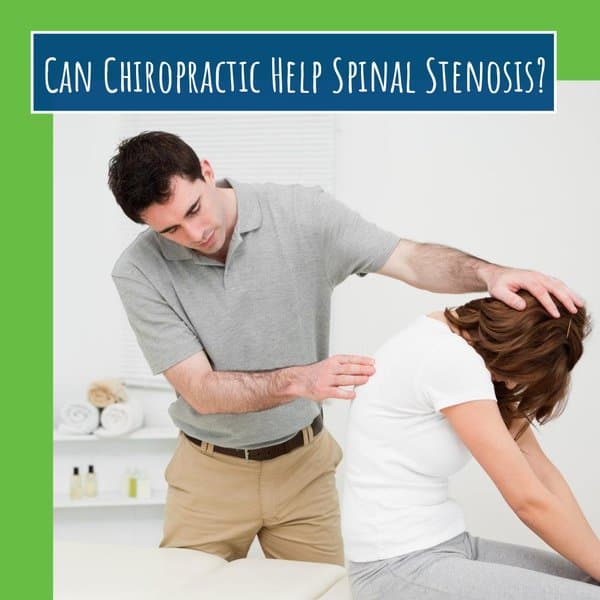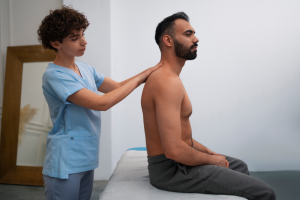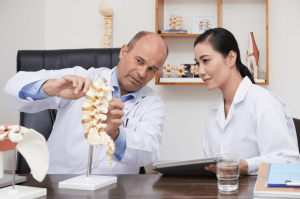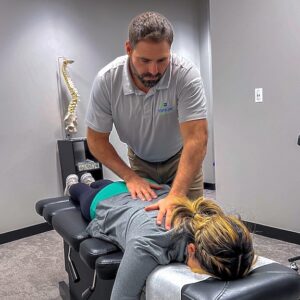The chiropractic approach to spinal stenosis is holistic and addresses the bottom line causes of the condition with the goal of long-term wellness. Chiropractic care focuses on non-invasive methods to reduce pain and restore function, providing an effective spinal stenosis treatment for many individuals seeking alternatives to surgery or medications.
The best chiropractic treatment for spinal stenosis will be guided by accurate diagnosis, possibly from X-rays or other diagnostic methods, and an understanding of the patient’s clinical history.
As professional chiropractors, we have seen many of our patients overcome spinal stenosis with chiropractic assistance (without resorting to surgery or medications).
Here are answers to some common questions our patients ask us:
What is Spinal Stenosis?
Spinal stenosis refers to the narrowing or compression of spaces within the spinal canal. This compression places excess pressure on the spinal nerve and can significantly affect signal transmission throughout the body.
There are two main types:
- Foraminal stenosis: Narrowing occurs where nerves exit the spinal canal, often impacting a nerve root.
- Central canal stenosis: Narrowing happens within the central spinal canal itself.
Typical locations include:
- Cervical region: Affecting the neck, often causing neck pain.
- Lumbar region: Leading to lumbar spinal stenosis, which is a common cause of lower back pain.
What Are the Symptoms of Spinal Stenosis?
As mentioned before, when the spinal bones press together, they interfere with the signal transmission functions of the nerves within the spinal cord. This neurological signal impairment often leads to:
Spinal stenosis symptoms develop when the spinal bones compress and disrupt the spinal nerve pathways. Common symptoms include:
- Feelings of pain and numbness in the neck and back
- Numbness in the legs and lower back
- Problems with balance and stability
- Difficulty in mobility in extreme cases of stenosis in the cervical spine
The above symptoms will affect either your upper back or lower back, depending on the part of the spinal cord where the stenosis has occurred:
- Cervical stenosis: Neck pain, weakness or numbness in the arms.
- Lumbar stenosis: Lower back pain, sciatica, leg cramping when walking.
Some patients also experience the “shopping cart sign,” where leaning forward on a cart provides temporary relief, highlighting the benefits of spinal flexion.
What Are the Causes of Spinal Stenosis?
Some cases of narrow spinal canals are congenital, but on most occasions, the condition is a result of several factors including:
Spinal injuries: Trauma such as those from car accidents or falls can cause a dislocation of one or more bones of the spine. The inflammation of the surrounding tissues after back surgery may similarly put excess pressure on the spinal cord and its nerve network.
Stiff and thickened ligaments: Each of the bones in your spinal cord have tough tissues that join them to other bones. When this tough tissue thickens and bulges, it can lead to a case of spinal stenosis.
Bone overgrowth: Conditions such as osteoarthritis can lead to wear and tear on the spinal bones, subsequently causing the formation of spinal spurs.
Old age/herniated discs: As you grow older, the soft cushioning material that works as a shock absorber between the spinal discs gradually dries out and flattens. The result is that the bones press heavily together and form bone spurs. Disc herniation may also be caused by injuries or a dislocation of the spinal bones.
Degenerative disc disease: The natural aging process or genetics can cause disc deterioration, contributing to lumbar stenosis or cervical narrowing.
Poor posture and prolonged sitting: These habits place additional strain on the lower back and may accelerate the development of lumbar spinal stenosis.
style=”text-decoration: underline;”>Poor posture and prolonged sitting: These habits place additional strain on the lower back and may accelerate the development of lumbar spinal stenosis.
How Do I Deal With the Pain From Spinal Stenosis?
There are several over-the-counter and prescription-based painkillers that might help you cope with the pain from a compressed spinal cord.
Please note, however, that this is a temporary solution. The painkillers do not address or correct the causative factor for your condition and pain. Increased use of painkillers without tackling the root cause of a disease has, in many cases, led to over-dependence on the pain meds. That is the story of America’s Opioid addiction crisis.
It’s also important to remember that pain is only one of the many symptoms of spinal stenosis. You can mask the pain, but what about numbness, loss of balance, muscle weakness and impaired mobility? These concerns, therefore, call for a more comprehensive treatment approach for spinal stenosis to correct not only the symptoms but stem out their original cause once and for all.
Alternative approaches include:
- Ice/heat therapy to manage inflammation
- Gentle stretching or yoga to improve spinal flexibility
- Physical therapy exercises designed to strengthen supporting muscles
- Following an anti-inflammatory diet rich in omega-3s and healing herbs
Working alongside chiropractic care, these strategies can significantly support long-term recovery by directly targeting the causes of pain rather than masking them.
How Does Chiropractic Care Help with Spinal Stenosis?
Chiropractic care is a wellness approach that targets healing through spinal manipulation. Many people wonder, can a chiropractor help with spinal stenosis? The answer is yes – chiropractic care provides a safe, drug-free pathway to managing spinal stenosis treatment.
In fact, there is reliable evidence to show that non-invasive and all-natural treatment options are effective against many forms of illnesses and health issues. Chiropractic is especially appropriate for spinal stenosis because it corrects and re-aligns dislocated and herniated discs, thus reducing pressure on the spinal cord and its joints and nerve networks.
Treatments typically include:
- Spinal Manipulation: Chiropractic adjustments help realign vertebrae, relieving pressure on the spinal nerve and reducing inflammation in the spinal canal.
- Therapeutic Massage: Loosens tight muscles, enhances blood flow and eases nerve root irritation.
- Spinal Decompression: This gentle traction therapy widens spaces within the spinal canal to relieve nerve impingement.
- Rehabilitation Exercises: Focus on posture correction, flexibility and strengthening the back to improve stability.
Personalized exercise and physiotherapy, which is also a part of chiropractic care, ultimately leads to physical strength, flexibility and optimal spinal support.
By combining chiropractic adjustment techniques with spinal decompression and rehabilitative exercises, our goal is to provide patients with better outcomes than spinal adjustments alone, addressing both symptoms and their underlying causes.
(Have you ever wondered, “Is Chiropractic Safe”? Click to read our in-depth examination)
Chiropractic Care for Stenosis vs. Surgery
Chiropractic care for spinal stenosis is non-invasive, as seen earlier. After an initial diagnosis, the chiropractic doctor will identify the affected areas of your spinal cord and direct manual or machine-assisted spinal manipulations on those areas.
These processes happen without you having to “go under the knife.” Chiropractic treatment for spinal stenosis is often preferable because it is non-invasive, takes less time for patients to recover after the treatment and the costs involved are comparatively much lower.
On the other hand, a surgical approach to spinal stenosis may require that the surgeon removes a part of your vertebrae to take the pressure off your nerves. They may also have to widen the spinal spaces where the nerves exit. These procedures may be done in several areas of your spine and bone grafts or metal implants are later used to join the affected areas of your spine.
The invasive nature of surgery is associated with risks. Something could go wrong during the procedure or the internal alteration and removal of parts of your spine could lead to future complications. The costs for the procedures are high, and it takes a long time for patients to recover. That’s not to say surgery is never a good choice but it makes sense to evaluate all your options.
Chiropractic Care for Stenosis vs. Medications
Chiropractic therapy aims to treat spinal stenosis without medication. That is achieved through manual spinal adjustment, stretches and other therapies. The treatment may also tackle your pain through massage.
Compared to medications, chiropractic therapy aims to get at the root of your issues and address the core cause. This approach is intended to be a long-term solution and does not carry any of the potentially harmful side effects of continuing to use pharmaceuticals.
The Role of Exercise in Relieving Spinal Stenosis
- Water aerobics: Offers resistance training with minimal impact on the spine.
- Yoga: Gentle poses like “child’s pose” help open the spinal canal and relieve pressure.
- Elliptical training: A better option for cardiovascular fitness compared to high-impact running.
How to Get Help With Your Spinal Stenosis
At Evolve Chiropractic, we provide evidence-based chiropractic care for spinal stenosis patients at our Illinois locations here:
We leverage the latest technology in the field, and together with our many years of experience, we welcome you to experience quick pain relief, long term wellness and improved quality of life.
Sources Include:
https://www.acatoday.org/News-Publications/Publications/ACA-Blogs/ArtMID/6925/ArticleID/440/Research-Review-Non-surgical-Treatment-vs-Self-directed-Care-to-Improve-Walking-in-Lumbar-Spinal-Stenosis
https://www.mayoclinic.org/diseases-conditions/spinal-stenosis/diagnosis-treatment/drc-20352966





